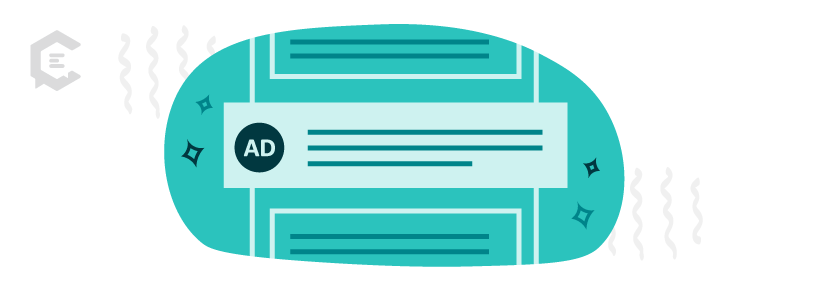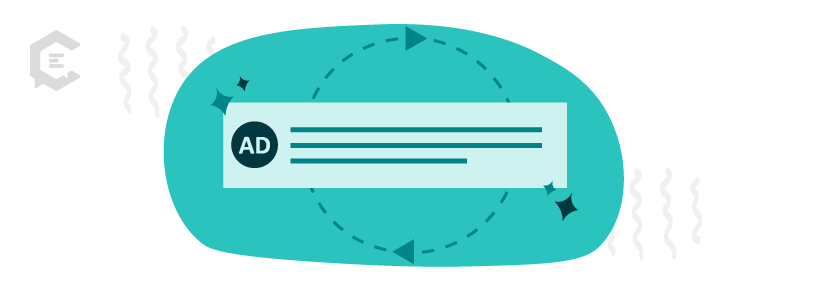Writing ad copy that converts well is never easy. A copywriter needs to create short, punchy text that moves the reader to take action. It’s a very specialized skill set among writers.
This is especially true for native advertising, where you’re often working with very limited space and in a highly structured format that doesn’t allow much flexibility. There are ways to navigate these obstacles, though, and produce native ads that get results.
Let’s start with a thorough understanding of the challenge.

What is native advertising?
Native advertising is a form of online advertising that matches the structure of the platform on which it appears.
Google’s sponsored search ads are one of the best examples of native ads because they resemble organic search results.
Facebook and LinkedIn both carry display advertising on their sidebars. But they also mix native ads into their feeds — ads that look like regular posts from friends or brands.
On Twitter, native ads look like tweets and appear in users’ timelines. And on blogs and websites, native ads generally match the look and feel of the site’s design.
How native advertising works
Native advertising generally works by blending in with the surrounding content.
The goal is to make the ad feel like it belongs there, rather than feeling like an interruption.
This native appearance can help increase engagement and click-through rates, as users are more likely to pay attention to an ad that doesn’t feel out of place.
Why native advertising is so successful
One of the main advantages of native advertising is that it’s non-intrusive.
Unlike banner ads or pop-ups, native ads don’t interrupt the user’s experience. They’re also more likely to be seen by users, as ad blockers may not block them.
How effective are native ads? In one study, 67% of internet users said they are more likely to click on a native ad than a display ad.
Typical formats for native advertising
There is no one-size-fits-all answer to this question, as native ad platforms can vary widely.
However, some standard native ad formats include:
- In-feed ads: These are native ads that appear in the main feed of content on a website or social media platform.
- In-article ads: You can set up native ad campaigns that will automatically adjust to match the colors and settings of the pages where they appear.
- Search ads: Native ads that appear in the search results of a website or social media platform and resemble organic search results.
- Recommendation widgets: These are native ads that appear as a list of recommended content on a website or social media platform.
Native ads vs. display ads
It’s important to note that native advertising is different from display advertising.
Display ads are the traditional banner ads that you see on websites. They’re usually rectangular and placed in a designated spot on a website.
Native ads, on the other hand, are designed to blend in with the surrounding content, making them less intrusive and more likely to be seen by users.
Tips for writing native advertising that converts
When writing any advertising content, your goals are to get the readers’ attention and then persuade them to move further along the buyer’s journey toward making a purchase.
Here are nine tips to help you do that.
1) Keep your audience in mind
Who are you trying to reach with your ad? Think about what tone would resonate with them and what words they find powerful.
For example, if you’re selling baby items, you’ll want to use language that implies safety, love, and warmth. But if you’re selling tools, your power words will center around ruggedness, strength, and durability.
2) Make sure your ad blends in
Your native ad should be formatted like the surrounding content in terms of headline length and layout. Readers will likely see right through it and move on if it’s not.
You’ll also want to keep in mind where your ad will be appearing. If it’s on a website, you’ll want to match the tone of the website.
For example, if you’re placing an ad on a site that’s known for its sense of humor, you’ll want to make sure your ad is funny as well. But if you’re placing an ad on a more serious website, you’ll want to make sure your ad is also serious in tone.
3) Write a catchy headline
Your headline is what will first grab readers’ attention, so it’s essential to make it count. Your headline should be clear, concise, and to the point. It should also be interesting enough to make readers want to learn more.
Some options include:
- Question headlines to pique curiosity.
- Surprising headlines to grab attention.
- How-to headlines that promise value.
- List headlines that are easy to scan.
- Controversial headlines that spark debate.
Consult lists of power words to find ideas that will give your headlines more impact. Here are some examples of power words:
- Ache
- Evil
- Admit
- Euphoria
- Indulge
- Scary
- Shameful
For example, instead of writing a headline like “Travel to Italy on a budget this summer,” you might write “Indulge your family in Rome for less than you’d spend at an amusement park.”
4) Build your case quickly
Once you have readers’ attention, you need to make your case quickly.
You only have a few sentences to do this, so make them count. Start by addressing the reader’s pain points and then show them how your product or service can help.
Use language that is clear and easy to understand. And avoid using industry jargon or padding your ad with weak language. Keep distilling your message by strengthening your nouns and verbs and eliminating excess verbiage.
For example, instead of saying, “BatX offers the best solution for your bat infestation problems,” say, “Evict your bats with BatX.”
If you can make your case in a single sentence, even better. If your native ads platform limits you to a specific word count, you may feel like you need to use every letter, but that’s not the case. Shorter is better, and white space around your message only makes it stronger.
5) Write your copy from your reader’s point of view.
Notice in the example above, that the subject of the sentence changed from the product, BatX, to the reader. This is an important distinction to make.
Your native ad should be focused on the reader and what they want, not on your product or service. Write your copy from the perspective of addressing your reader’s needs.
Convert all your product’s features into consumer benefits. For example, instead of saying, “Our product is made with 100% recycled materials,” say, “You can feel good knowing our product is made with 100% recycled materials.”
6) Don’t waste your images
The right image can do the work of a thousand words. Images can capture a reader’s attention, make them curious enough to read the content, and help drive them toward a purchase.
But boring photos won’t accomplish any of that. You need to think in terms of visual marketing instead of simply illustrating your content.
The best photos tell a story and compliment your headline. For instance, if you’re selling a luxury car, you could add a photo of the car. Or you could show the car driving through gorgeous scenery ad with the headline, “Escape the city.”
In the BatX example above, you could show a photo of a box of BatX. (Well, not really. We made it up!) Or you could show a closeup of a horrified woman with a bat tangled in her hair. Which photo would catch your eye?
In general, images with people — and especially closeups— get the best results. But any image that tells a story and surprises the viewer can be a powerful addition to your ad.
7) Call them to action
What do you want your reader to do? Should they make a purchase, follow a brand, sign up for an e-mail list, or make a reservation? Be sure to include a call to action (CTA) that is clear and easy to follow.
Your CTA should be specific, such as “Buy now,” “Sign up today,” or “Reserve your spot.” And it should be placed in a prominent spot so that readers can’t miss it.
If you study the CTAs that have been successful for other companies, you’ll find lots of ideas and inspiration. For example, you might invite your reader to download a case study, view an offer, get a free gift, or install a trial.
8) Consider your buyer’s journey
Which CTA you choose can make a big difference in your conversion rates. It’s much easier to persuade people to “learn more” than to “buy now.”
If your product is the kind of thing people might buy on impulse, at a low price point, then a “buy now” CTA might make sense. But for big-ticket items, you may want to offer an incentive to join your mailing list and develop an email drip campaign that will close the sale later.
9) Test, test, and test again
You can’t improve your native advertising conversion rates if you don’t track your results. Set up goals in Google Analytics and use A/B testing to see what works best. By testing different native ad campaigns, you can learn what works for your business.
For example, you could test different headlines or images to see which ones perform better. Or you could experiment with different CTAs to see which ones get more clicks.
You may also want to segment your audience and test native ads specifically for them. For example, if you’re selling a new product, you might want to create a different ad for people who are already familiar with your product line — those who follow you on social media or who have already visited your website.
By testing different elements, you can gradually improve your native advertising conversion rates and get the most out of your native ads campaigns.
Native advertising is a type of online advertising designed to blend in with the surrounding content. It is less intrusive than display ads and can, therefore, be more effective.
When writing native ads, keep your audience in mind and make sure your ad is styled like the surrounding content. Write a catchy headline, build your case quickly, and include compelling images. Make sure you include a clear call to action to convert your reader.
By following these tips, you can create native ads that are both effective and unobtrusive. And you’ll be able to improve your native advertising conversion rates.
If you’d like to connect with highly skilled writers who know exactly how to create compelling content of all kinds, ClearVoice can help.







